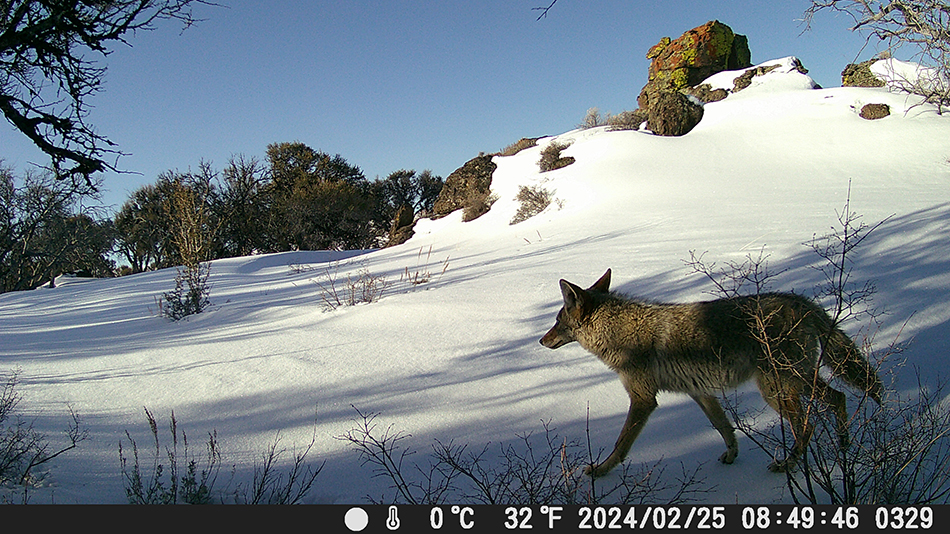Winter and spring were full of wildlife activity. We captured it on camera and are excited to share highlights as a valuable volunteer effort evolves.
Animals move across the landscape at different speeds for different needs. Many people find joy in watching wildlife fly, crawl, gallop or prowl from one place to another while also wondering what they are doing when nobody’s watching. We share this curiosity, and understanding wildlife movements helps us conserve and restore the areas they use to survive, sometimes by observing from afar, months later, via a screenshot or video.
We installed wildlife cameras along trails and creeks before the snow fell last fall. Watching these cool, wintery moments now during a hot summer can be refreshing and reminds us of the drastic changes animals experience throughout the year. We hope you enjoy these highlights and that you can join us in related volunteering activities to conserve and restore wildlife habitat in the future!
Cameras across ODLT’s properties showed birds and mammals wandering on their own, or fending off others to get a meal. In winter, animals left tracks in the snow at day and night. Some were on leisurely strolls or prowling in the dark on a route shared by skunk, rabbit, bobcat, coyote and mountain lion. We’re eager to see new and familiar faces in the next set of images we collect this fall.
This conservation work wouldn’t be possible without your help! We started with a couple cameras in 2022, but growing support allowed us to purchase more camera units and better understand the land we manage. The cameras are helping us learn which animals are frequenting which areas and get glimpses into patterns of use. This information helps guide our conservation management plans and broaden volunteer opportunities on our properties.
From April-November each year, we welcome your help conducting annual inspections to track current conditions and restoration needs at ODLT far-flung properties. This is a great opportunity to see first-hand where we work in Oregon’s high desert and help us install new or remove old wildlife cameras.
We haven’t had a camera at our Brothers-Shaw property since 2022, but that will soon change. Coyote, badger, pronghorn, jackrabbits, hawks and songbirds all made appearances and we hope to add burrowing owls to that list. In October of 2024, volunteers created artificial burrows to support the return of burrowing owls and cameras will track who ultimately takes up residence at the new burrows. Stay tuned for updates!
It’s been a pleasure seeing who shows up on the cameras, whether it’s weeks or months later. It’s a reminder of the collective efforts that fuel and uplift our work. We’re happy to continue sharing these highlights and hope it inspires your continued support of conservation across Oregon’s high desert!
Published July, 2024
View Wildlife Camera Videos
Discover details of the highlighted regions
More perspectives
Related Reads
Reaching for new heights in conservation
Together, we can conserve Disaster Peak Ranch!
Going with the flow
We're restoring a creek to help fish and wildlife.
A land of learning
Local Tribal members shared stewardship practices to inspire youth.
Looking out for the birds
Volunteers help guide restoration plans with wetland bird surveys.
Watching wildlife
Wildlife cameras help with conservation plans for animals throughout the year.
Virtual fences mooove cows online
Virtual fence is a new technology that can help land managers maintain wildlife connectivity in permitted grazing areas.
Tribal Gatherings
Tribal leaders discussed the Native history and stewardship of their homelands at Trout Creek Ranch.
Research fueled by fire
Oregon State University finished 10 years of fieldwork on sage-grouse responses to wildfire.
Tribal Stewards
Tribal teens lead on conservation efforts through Northwest Youth Corps.
Spring returns
Rod Klus returns to researching sage-grouse for Oregon Department of Fish and Wildlife.
Mountains of Research
Researchers spent a summer in the mountains and left with more than data.
Spreading wings in conservation
Jack Strang created new connections to the high desert during our first internship.
Neighbors helping neighbors fight fires
Rangeland Fire Protection Associations protect the high desert and each other.
Watching for wildfires
A live camera on Beatys Butte helps wildfire efforts in the high desert.
Spring into recreation & conservation
John Sterling works at the intersection of both as a volunteer board member.
Balancing a range of concerns
Angela Sitz brings wild and working lands together.
Wildlife encounters
Land Trust volunteers are keeping track of animals on the ground and on camera.
Keeping it connected
Closing the unnatural gap between wildlife refuges opens doors for pronghorn.
Seeing the land in a different Light
Northern Paiute Tribal member Wilson Wewa brings a Native perspective to ODLT's work.




























